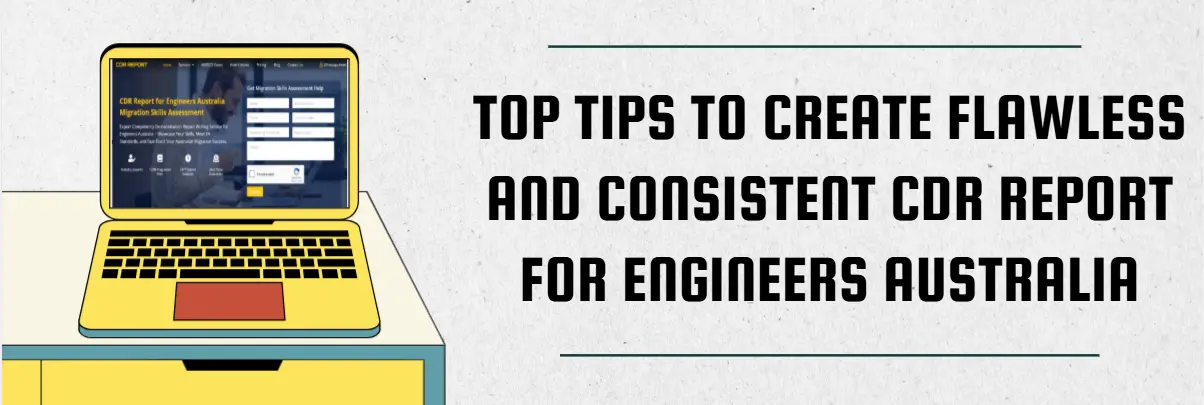For engineers planning to migrate to Australia, the Competency Demonstration Report (CDR) is the most crucial step in the approval process. It determines whether you meet the standards set by Engineers Australia (EA) and are eligible for skilled migration.
A well-prepared CDR not only highlights your technical expertise but also shows your ability to apply engineering skills in real-world scenarios. Precision, consistency, and structure are what separate successful reports from rejected ones.
Based on years of experience, here are the top strategies to ensure your CDR is flawless and consistent.
1. Understand the CDR Framework
Engineers Australia evaluates three core competency areas:
- Knowledge and Skill Base (35%) – Your engineering principles and problem-solving ability.
- Engineering Application Ability (40%) – Practical application, project management, and design experience.
- Professional and Personal Attributes (25%) – Communication, teamwork, ethics, and leadership.
These are assessed through your Career Episodes, CPD (Continuing Professional Development), and Summary Statement. Keeping them aligned and consistent is key to success.
2. Plan Before You Write
Many engineers jump straight into writing and later face inconsistencies. Good preparation saves time and ensures clarity.
- Review Your Experience: List major projects, roles, and responsibilities.
- Map Competencies: Match each project with EA’s required elements.
- Gather Evidence: Collect drawings, reports, certificates, or calculations.
- Choose the Right Projects: Pick those where you had significant responsibility, solved problems, and demonstrated leadership—not just observational roles.
3. Write Strong Career Episodes
Your Career Episodes are the core of your CDR. Each should demonstrate how you applied engineering knowledge and skills in a real project.
Recommended Structure
- Introduction (200–250 words): Project details, your role, and timeline.
- Background (300–400 words): Objectives, technical context, challenges.
- Personal Engineering Activity (1,800–2,000 words): Your specific actions, problem-solving, and results.
- Summary (200–250 words): Key achievements and competencies demonstrated.
Balance Technical Detail
Explain technical aspects clearly but avoid excessive jargon. Assessors may not be experts in your exact field, so clarity matters. Use diagrams, tables, or flowcharts where useful.
4. Maintain Consistent Language and Tone
Consistency in writing style shows professionalism. Inconsistencies can raise doubts about authenticity.
- Voice: Use first-person active voice (“I designed…”).
- Tense: Use past tense for completed projects.
- Tone: Stay professional and factual—neither too modest nor exaggerated.
- Terminology: Stick to consistent technical terms and abbreviations throughout.
Tip: Create a small style guide for yourself before writing to ensure uniformity.
5. Demonstrate Competencies Through Evidence
Don’t just state your skills—prove them with examples and measurable results.
- Technical Expertise: Explain how you solved a design or engineering challenge.
- Project Management: Show planning, scheduling, budgeting, or coordination efforts.
- Communication: Mention reports, presentations, or stakeholder meetings.
- Leadership: Highlight team management, guidance, or decision-making.
Whenever possible, quantify results (e.g., reduced project cost by 10%, improved efficiency by 15%). Numbers strengthen your case.
6. Review and Edit Thoroughly
Even the best-written reports can fail if errors are overlooked. Build a multi-level review process:
- Self-Review: Check for completeness and accuracy.
- Technical Review: Ask a senior engineer or peer to review technical content.
- Language Review: Ensure grammar, spelling, and style are correct.
- Final Review: Do a fresh read for flow, formatting, and consistency.
Common errors that lead to rejection include mismatched timelines, weak technical detail, poor English, and inconsistent formatting.
7. Align Your CPD with Career Episodes
Your Continuing Professional Development (CPD) record should reinforce your career story and prove your ongoing commitment to growth.
Examples of CPD activities include:
- Formal learning (courses, certifications)
- Seminars, workshops, or professional memberships
- Self-learning (reading technical journals, research)
Ensure your CPD aligns with your career episodes and reflects increasing responsibility over time.
8. Final Checks Before Submission
Before submitting your CDR, make sure every component is complete and properly formatted.
- Career Episodes: Structured, word count within range, consistent timelines.
- Summary Statement: Competency cross-references clearly mapped.
- CPD: Well-documented and aligned with your growth.
- Formatting: Consistent fonts, spacing, and headers.
Presentation matters—clear, professional formatting makes a positive impression on assessors.
Creating a flawless CDR for Engineers Australia isn’t about writing the longest report—it’s about clarity, consistency, and competency alignment. With proper planning, careful project selection, strong career episodes, and thorough reviews, you can significantly improve your chances of approval.
Remember: your CDR is more than a migration requirement. It’s a showcase of your engineering journey and your potential to contribute to Australia’s engineering profession. Make every section count.
